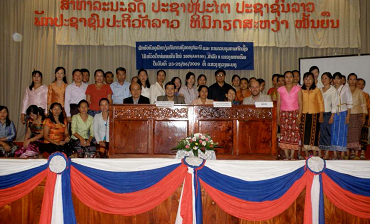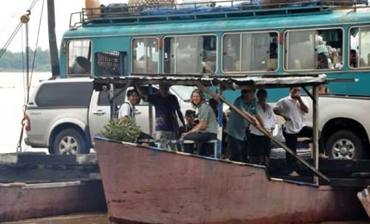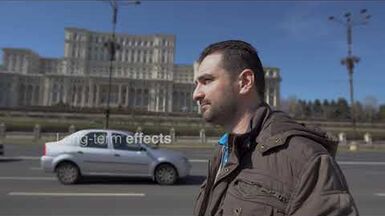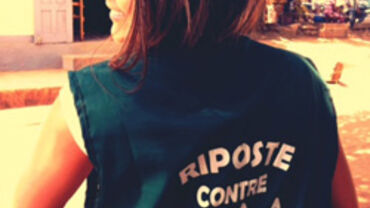With Love from Laos: The Land of a Million Elephants and the White Parasol
By Hannah Lewis (EPIET Cohort 12, WHO Laos) and Christian Winter (PAE Cohort 12, WHO Laos).

Hannah: When I arrived in Lao PDR in November 2008 it was my first time in the country and my first position with the World Health Organization. Thanks to an informal dinner briefing and many e-mail exchanges with my predecessor, Annick Lenglet (EPIET cohort 10) and support from Amy Cawthorne (EPIET cohort 9) in the regional office, the transition was relatively smooth. However, they hadn’t prepared me for how long and hot the rainy season would be, that intestines come in all shapes and sizes in Lao dishes (offal is my one pet hates!) and that Beer Lao has almost a complete monopoly on alcohol sales and advertising!
Culturally it was a bit of a shock but I soon learnt that in spite of being a poor and small landlocked country with a turbulent political history that Lao people are extremely open and friendly and the country is beautiful with many parts left unexplored.
Christian: I joined the Communicable Disease Surveillance and Response (CSR) team at the WHO Lao Country Office when pandemic H1N1 2009 hit the world. Being members of the CSR team, both our jobs involve capacity building in the country – supporting our national counterparts to develop the public health system (surveillance and response, clinical management, infection control, zoonoses and communication).
As this was the first time either of us had worked on surveillance and response issues in a developing country, there was a very steep learning curve.
Core epidemiology skills are key as the surveillance system is in its infancy and basic principles such as data checking and validation and even data analysis are not standard practise, especially once outside the national epidemiology institute. Our CSR team is currently large with seven international and a similar number of national staff and there is a fantastic team spirit.
Being in a supportive role can be tough sometimes – it would often be much easier to do things ourselves than explain the need and then the principles behind, for example, an epidemic curve. Also, it is sometimes hard to relinquish control over a work project and not to feel responsible for the outcome but at the end of the day we are just assisting. However, the work can also be amazingly rewarding.

Hannah and Christian: We were lucky enough to start at WHO just as the first cohort of Lao Field Epidemiology Training (FET) started. Eight central and provincial doctors with very little epidemiological training are being put through a one year FET course comprising lectures (by national staff and WHO) and field work. Lecturing the FETs on different topics such as basic epidemiology, and accompanying them on outbreak investigations has been fun and inspiring. We’ve also learnt a lot about epidemiology in a developing country from them and are constantly surprised by how quickly they are picking up new concepts and applying them. We are very happy that an ‘EPIET’-like spirit is present as we see them assist each other and provincial colleagues and having fun when socialising together. We’d like to thank EPIET for letting us use some training material – the co-ordinators would be very impressed with their EPIET-style presentations!
Hannah: Naturally, like most epidemiologists world over we are now consumed with pandemic H1N1 2009. I have been supporting national epidemiologists with enhanced surveillance.
I have assisted in initiating ILI clinical surveillance nationwide for the first time, integrating different types of influenza data and determining criteria for sample collection so that the national laboratory does not become overwhelmed.
Christian: I have been responsible for clinical management and infection control of pandemic H1N1 in the country since the beginning of the pandemic. The health care system is set-up in a hierarchical way, with six central hospitals, 16 provincial hospitals, 127 district hospitals and 750 health centres. In spite of having short-comings, this system facilitated the organization of nation-wide H1N1 training using the train-the-trainer method. I supported this training by developing training agendas, up-to-date guidelines, presentations and case scenarios. Using interactive case scenarios for group work and discussions was a very effective and a new learning method for most Lao clinicians. I learnt a lot myself during these trainings, like how to spontaneously give a speech in front of hundreds of participants! I was very glad that translation into Lao was required, giving me time to think what to say next…
Alongside these activities, our work has become very applied – providing option papers for the MoH– from definitions for community wide transmission and criteria for Tamiflu use to whether various public health measures such as community mask use and school closure are effective in the Lao context. As most, if not all, H1N1 epidemiological information has come from countries more developed than Laos we await to see how the pandemic will pan out here.
With many ethnic minority groups, particularly in remote hard to reach areas and a basic health care system, the months ahead are likely to be challenging especially with the upcoming South East Asia (SEA) Games.
Meanwhile, dengue is also a neglected but very present threat in Laos and we have been working to improve surveillance, control, and clinical management in the country. We have also had trips to the field for both workshops (pandemic planning, clinical management) and outbreak investigations.
The outbreak investigations are often to remote provinces where conditions are basic and very little information can be gleamed before arriving at the scene.
As laboratory testing is so limited and when available, takes time, good descriptive epidemiology is important in trying to determine the source of the outbreak and informing on control measures. Of course, life in Laos isn’t just about work! We socialise a lot with our work colleagues and "expats" from all over the world. There is little nightlife in Vientiane as the culture is very family-orientated. We socialise mostly though sports and dinner, but also escape once in a while to Bangkok or Kuala Lumpur to enjoy the offers of a city-life, including cinemas, shops and escalators (there is only one in Vientiane!).
We also both love exploring Laos and have been on weekend trips, mostly on our motorbike – exploring waterfalls and caves, climbing and hiking.







